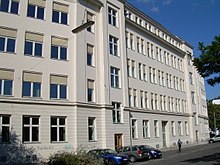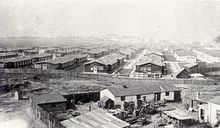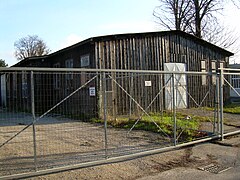Favoritner Gewerbering
The Favoritner Gewerbering , also known as the veil barracks, is a ring-shaped alley in a company site in Vienna's 10th district of Favoriten . The outer boundaries of this area are formed by Grenzackerstraße , Daumegasse , Ricarda-Huch-Weg , Hebbelplatz (with the Schleiergasse access from which it is named ) and Hentzigasse . The area is on the Boschberg between Laaer Berg and Wienerberg .
history
In the war in 1914 which set up kk -österreichische Ministry of the Interior, the kuk Wiener War Hospital №. 1 in Vienna XVI ( Penzing ) and the Vienna War Hospital №. 2 in Favoriten (in the Kaiser-Franz-Josef-Spital in Kundratstrasse near the Spinnerin am Kreuz ), both equipped with isolation wards for cholera occurring on the Eastern Front . Due to a lack of space - due to the large number of wounded and infected soldiers arriving in Vienna - the Austro-Hungarian Reserve Hospital No. in the Erzherzog-Franz-Ferdinand-Kaserne (today Starhemberg-Kaserne in Troststrasse ) had to be established. 19, a branch of this reserve hospital was located in the school on Hebbelplatz.
Right next to it, in the then undeveloped southern course of Schleiergasse, a barrack camp for the disabled schools of the Reserve Hospital was built. 11 (Orthopädisches Spital Gassergasse in Vienna V - Margareten , head of Hans Spitzy ). The land was bought cheaply from Inzersdorfer brick manufacturer Heinrich Drasche , a sponsor of the training for disabled people. Even after the end of the World War in 1918, war invalids continued to be cared for and retrained. Three barracks were taken over by the Disability Compensation Commission and continued to be used until 1922.
From 1922 these three barracks were rededicated as living quarters for the disabled, the rest were rented to small businesses. These residential barracks, also known as dormitories, were still in use as residential "houses" with some renovations into the 21st century.
After Austria was annexed to the German Reich , the NSKOV ( Nazi war victims' supply ) took over the barracks in March 1938 .
Between April 7 and 8, 1945, the advance of the Red Army from the south led to fighting here too.
With the conversion of the Favoritner Gewerbering from October 1st, 1984 into an access road, the industrial park got its current appearance under the name "Gewerbehof Schlebareacken".
The disabled school of the Imperial and Royal Reserve Hospital № 11
The tasks of the schools for the disabled are described in the memorandum of Prime Minister Count Stürgkh from 1915, which was about restoring the ability of war disabled persons to work. More precise information was also available for any new buildings that might be required. It said in chapters 2 and 3 that the buildings
- “Can be carried out very quickly and at the lowest possible cost, so as a rule not stone buildings, but solid, hygienic wooden buildings (barracks) should be built. [...] It should not only be remedied to the current needs, rather the created sanctuaries should also be available for later times and made usable for the civilian population. " ( Excerpted quote)
With this in mind, the barracks at Schleiergasse 17 were built, 14 training and 30 accommodation barracks were built. Courses were offered for a wide variety of professions:
- Shoemaker, tailor, saddler, carpenter, upholsterer, letter painter, photographer, bookbinder, machine and building fitter, blacksmith, scissor grinder, watchmaker, hairdresser, dental technician, plumber, plumber, basket weaver, furrier, stonemason, postman, telegraphist, and a few more. In the winter months, when outdoor training in the agricultural training centers in Mödling and Ebreichsdorf was not possible, agriculture and gardening were also on the program.
There were also further training courses (including school leaving and language courses) for the sometimes quite uneducated soldiers from rural areas.
A pastoral care center in the form of a wooden chapel was built on the site. The exact date of the inauguration can no longer be determined, but it was probably the early summer of 1916, as can be seen on two photographs. After the school was closed, the wooden structure was moved to Quellenstrasse in 1922 and served as the emergency church "Queen of Peace" .
The veil barracks from 1922 until today
The already mentioned slow settlement of small businesses in the majority of the barracks no longer used for the school for the disabled changed the area significantly. During this time, the popular name "veil barracks" came into being. From 1922 to 1938 around 40 objects were in use, some of which were added outside of the former hospital grounds. In Schleiergasse there was a porter's house with an attached tobacco shop (tobacco and newspaper shop). Well-known commercial enterprises at the time were Kesselbau Löblich & Co. (still existing here today), the cardboard box production Heinrich Boog & Co. with 105 employees in three barracks, the stove companies "Phönix" and "Reich" with up to 100 workers in two barracks , the porcelain factory "Keramos", a flag factory, toys, hats and jerseys, carpenters, saddlers, book printers, metal processing companies, the restaurant "Auf der Alm" with an attached grocery store, and many others.
In an act of the Vienna Municipal Department 37 (building police) from September 22, 1937, a complaint from the district was received about the building fabric, which has now become desolate. Some of the commercially used properties also had “serious deficiencies in terms of industrial hygiene and sanitation” . The industrial inspectorate stipulated the installation of efficient ventilation and the use of protective clothing in a textile printing plant when there was threat of closure.
From March 1938 the veil barracks were under the administration of NSKOV. Many of the settled businesses were Aryanized . In place of the PRODWI (production cooperative of the Viennese war invalids and war survivors), which had previously existed on site and was located in objects 24 and A, the NSKOV set up an administration and support center.
After the end of the fighting around Vienna in April 1945 and the subsequent denazification of the Aryanized companies, the later Gewerbering slowly developed, according to a contemporary comment, into a "strange motley dilapidated barracks and intact company buildings in the midst of a wild park landscape" . Since there was a threat of razing, in 1979 the 40 companies that existed there merged to form an association and bought the land from the Republic of Austria as the property owner at the time. A photo documentation of its history by Johann Faber was presented in 1982 in the Museum of Modern Art in Vienna's Schweizergarten and awarded the Ministry of Education's sponsorship award for artistic photography.
Today, the majority of the wooden barracks in what is now the "Schlebareacken industrial estate" have been replaced by modern industrial buildings. The private radio operator KroneHit can be found on the corner of Ricarda-Huch-Weg and Daumegasse , along the Grenzackerstraße there are petrol stations, a car dealership and a technical service of the ÖAMTC , in Daumegasse there is a branch of the FH Campus Wien .
literature
- Memorandum on the measures taken by the Imperial and Royal Government on the occasion of the war up to the end of June 1915. With a foreword by Prime Minister Karl Stürgkh, Hof- und Staatsdruckerei, Vienna 1915.
- Klemens Dorn: Favorites - a home book of the 10th Viennese district, Vienna 1928.
- Johann Faber: The Favoriten Business Park. Wien aktuell, issue VI, December 1982.
- Anton Lang: The “veil barracks” - from the disabled schools to the industrial park. Favoritner Museum Blätter number 25, Museumsverein im Bezirksmuseum Favoriten , Vienna 2000.
- Hans Spitzy: Our war invalids - facilities for healing and care, pictures from the kuk Reserve Hospital XI, Vienna. Seidel & Sohn publishing house, Vienna 1915.
Web links
- Site map on openstreetmap
- History of the veil barracks on meinviertel.at
Individual evidence
- ↑ Memorandum 1915, pp. 285–286.
- ↑ Spitzy: Our war invalids , p. 21 ff.
- ^ Dorn: Favoriten , p. 135.
- ↑ a b Lang: Die “Schlebarenbaracken” , p. 45
- ↑ Lang: The “Schle barracks” , p. 15.
- ↑ Lang: Die "Schlebarenbarenacken" , pp. 32–36 (with photographs of the chapel in the disabled school).
- ↑ Information from Lehmann's address book from 1938
- ↑ Lang: Die “Schlebarenbarack” , p. 38.
- ↑ Municipal District Office for the 10th District - Trade Inspectorate, MBA 10-3552 / 1924, from February 29, 1924.
- ^ Faber: The industrial park Favoriten , S. XV.
- ↑ Fh Campus Vienna / Daume alley
Coordinates: 48 ° 9 ′ 52.5 ″ N , 16 ° 22 ′ 39.9 ″ E








